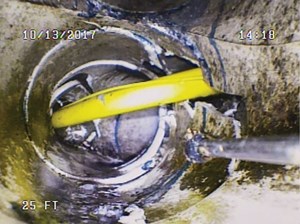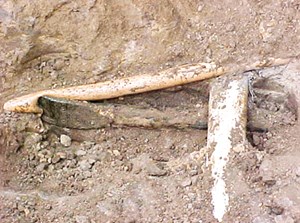August 2020 Vol. 75 No. 8
Features
Cross Bore Risk Reduction Protects Contractors
Mark Bruce | President, Cross Bore Safety Association
Pipeline installation contractors, in the late 1990s, were industry leaders in the move to minimize risk from cross bores. The risk to the public, employees and their enterprise value was recognized after incidents resulting in explosions. This article focuses on contractor-related benefits of using the leading practices.
Published in February 2020, by the Cross Bore Safety Association, Leading Practices for Cross Bore Risk Reduction is the direct result of the industry’s expressed desire to have a high-confidence guidance document to help ensure cross bores are not created and, if existing, eliminated.
High Stakes
Reported costs of a single cross bore have been as high as $30 million. Deaths, serious injuries and property damage have resulted infrequently, but on occasion, catastrophically. The impact to the public and worker safety is paramount.
As a result, it is recognized that prevention and elimination are more efficient and productive than the cost of allowing cross bores to remain.
CGA’s4 annual DIRT5 reports show natural gas distribution accounts for the largest cost category of construction damages – nearly one-half.
Natural gas distribution cross bores pose the most significant risks. According to the Common Ground Alliance 2018 Damage Information Reporting Tool (DIRT), they account for the largest cost category of construction damages – nearly one-half.
Accordingly, gas lines are this document’s primary focus. But the information is useful for all – new and legacy – utilities and trenchless construction
A gas line in sewer is a ticking time bomb until removed. A utility bored through a sewer can be cut when a homeowner calls a drain cleaner to clear a back-up. Rotating cutting tools can be used where roots are thought to be present. Plastic can be cut by these same tools.
A cut gas line releases gas into a structure, where any ignition source can cause a fire or explosion and risk to property, contractors, emergency responders and residents. Just walking up to a home in the area of a cross bore that is releasing gas could be deadly, if the explosion ignites at the same time.
All cross bores are dangerous. An electric line intersection could result in immediate injury or death to the operator of installation equipment or drain cleaner.
At a communications HDD bore that intersects both a gas line and sewer lateral servicing a house (Class 2 cross bore, Photo 2), gas entered the sewer through the annular gap around the bore, flowed into the house through the sewer, and resulted in an explosion (Photo 3).
In other words, beware of complacency that can come with thinking that only a relatively inert type of utility is being installed.
Prevention, Elimination
While holding significant advantages in reducing environmental impact, and community disruption, and ultimately lowering costs, trenchless installation methods also have high risk of creating cross bores.
Percussion moles, for example, can be guided only by their initial positioning. If rocks, roots or other objects are hit as the percussive action of the mole moves it forward, unseen deviation from planned alignment can occur.
Plows can install utilities by pulling a vertical, curved, steel plate through the soil while feeding a small-diameter utility into the ground simultaneously. There is no opportunity to observe the bottom of the excavation.
Horizontal directional drills (HDD), the newest trenchless tools, are steered by using sondes and receivers respectively emitting and receiving radio frequencies. Varying by machine size, accuracies generally have a range of +/– 2 feet for horizontal location. Vertical depth may or may not be accurate, due to calibration error or interference from local anomalies.
We just need to ensure the construction includes processes to avoid cross bores (and other damage). We also need to identify and remove cross bores created from long-past installations. This is a huge task, with estimates putting frequency at 2.3 cross bores per mile of mainline and lateral sewers inspected.
Leading Practices for Cross Bore Risk Reduction provides guidance on preventing and eliminating cross bores with better practices and consistent implementation of thorough, verifiable processes.
Using safe practices is not only mandated by regulation, but can be a significant differentiator for companies when bidding work and hiring staff.
Contractor Solutions
To be sure, there are many aspects of reducing damages from cross bores. The stakeholders who can contribute to risk reduction are numerous. There is greater discussion of all stakeholder elements in the full, 88-page document.
With a focus of this article on contractors, specific guidance is included below:
- Ensure that all utilities are known. 811 locate laws generally exempt sewer utilities from performing useful locates. Where sewers are not fully located, extra efforts must be taken. Often, inspection cameras with transmitting radio sondes are used to locate the sewer lines and navigate branch laterals that may be present.
- Include post-construction inspections of sewers, typically with CCTV cameras, to ensure a cross bore was not inadvertently created. Track the traverse to ensure the inspection extends beyond the cross-bore risk, typically with GPS-collected mapping. Validate with secondary review.
- Follow requirements for exposing all crossings. Leading Practices for Cross Bore Risk Reduction includes optional recommendation for verification. Locate the daylighting by using GPS, plus either a photo or video showing the two utilities crossing safely, with date and location. Save these records for separate validation.
- Specify safe installation operations in work documents and the owner of the utility should ensure safe operations are being conducted. Follow-up verification by inspection is appropriate in most cases. Include the costs for safe operations in the utility budget and reflect them in fair evaluation of bids. A lower price is not a good deal if safe processes are not being used.
- Contractors should evaluate and recognize the risks of working for utilities that do not have specific processes to adequately support consistent implementation of Leading Practices for Cross Bore Risk Reduction and other damage prevention measures. Weak damage prevention and verification requirements of a utility may result in higher risks to the contractor. The contractor may even determine the risk does not justify working for that utility.
- Use verifiable processes that will confirm safe damage prevention has been implemented and used beyond the full extent of the risk. Save confirming data long-term; if an issue comes up later, defense preparation will be rapid and less costly.
- Review and adopt Leading Practices for Cross Bore Risk Reduction, as appropriate to your application.
In summary, high-confidence and verifiable processes are the friends of contractors and utilities. Using Leading Practices for Cross Bore Risk Reduction can help achieve your safety and financial goals while protecting the continued use of trenchless methods. •
Mark Bruce is a civil engineer, with 45 years of experience in the construction, manufacturing and services industries, including 20 years of ISO 9001 quality system expertise. Currently, he is serving as the president of the Cross Bore Safety Association. mark.bruce@crossboresafety.org






Comments